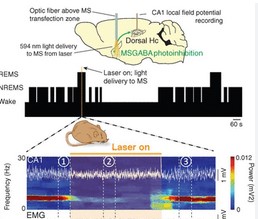Wednesday, 15 November 2023
Memory consolidation during REM sleep

Out of all the experiments that have been done on memory consolidation and REM sleep, there is one, published in 2016, that I especially love mentioning because it was done at the Douglas Hospital research centre that enabled me to develop this website. Sylvain Williams and his research team successfully used optogenetics to silence inhibitory neurons in the medial septum of mice. Without disturbing the animals’ sleep, the researchers were able to greatly attenuate the 4 to 8 Hz theta rhythm that is associated with memory consolidation during REM sleep. Upon awakening, the mice did not remember the new location of an object. This treatment also disrupted a fear that had been conditioned in a certain context. In contrast, silencing the inhibitory neurons in the medial septum outside of episodes of REM sleep had no effect on memory.
The authors therefore concluded that the theta rhythm, which depends on the activity of the neurons in the medial septum, is essential for the consolidation of contextual memory during REM sleep. Interestingly, several studies (for example, this one, this one and this one) indicate that it is the neurons resulting from neurogenesis during a mouse’s adult life that contribute the most to the memorization of a conditioned fear during REM sleep.
Memory and the Brain, Sleep and Dreams | Comments Closed








